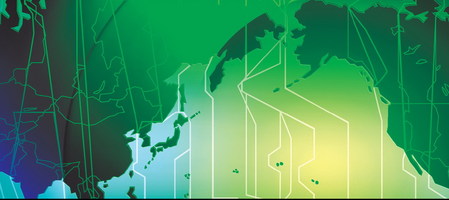Digital Printing
Outdoor Takes An Eco-Friendly Route
Outdoor-advertising companies are commissioning vendors to develop products that help protect the environment.
Published
17 years agoon

Taking measures to be environmentally conscious isn’t new for the outdoor-advertising industry. For years, the industry has been committed to using recyclable and recycled materials whenever possible and finding additional uses for used billboard vinyl.
After a hurricane ravages a community, a sea of FEMA-issued tarps covers the damaged roofs of homes and businesses. Often, the sea of many colors comprises used billboard vinyl donated to cover hundreds of damaged structures. In the hurricane belts, outdoor companies don’t ship out used vinyl until post-hurricane season.
Now, however, the outdoor-ad industry stands at the threshold of a new generation of eco-friendly products and initiatives that will positively impact the Earth and skies, and even promote worker safety.
New non-vinyl substrates
More than 20 years ago, the outdoor industry began using computer-printed vinyl, which allowed images to be rendered more quickly, cleanly and durably. Today, new recyclable, lighter-weight substrates being developed reduce solid waste and make installation safer and easier.
AdvertisementCircle Graphics is one such company. Clear Channel Outdoor (CCO) approached the company several years ago to see if it could create 100% recyclable, flexible-face materials. Mike Deeds, executive vice president, operations, for CCO, said, through the two companies’ synergy, Eco-Flexx was developed to meet the outdoor industry’s long-standing goal.
Rod Rackley, Circle Graphics’ executive vice president, explained, “Eco-Flexx is a lightweight, non-PVC, recyclable, vinyl-replacement material. Because it’s 100% polyethylene, it can be easily recycled. The recycled polyethylene resin can be used again to make various new products. Circle Graphics will organize the recycling of the material as needed, though several polyethylene recycling companies exist throughout the country.”
A 14 x 48-ft. Eco-Flexx substrate weighs approximately 20 lbs, versus the typical 75 lbs. for a 14 x 48-ft. PVC flex. According to Bill Murphy, executive vice president, national operations manager at CBS Outdoor, the new substrate would not only represent an environmental coup for the industry, but substantially reduce the weight of the industry’s most frequently handled product.
Murphy said, “That will save labor and reduce reliance on expensive and fuel-consuming crane trucks. Like any responsible company, we want to be as green as possible, and that means looking for opportunities to substitute more environmentally friendly products. Eco- Flexx certainly appears to be one such product.”
Every flexible-face bulletin copy change doesn’t require a crane truck. Some operators have been installing mechanical jibs, and significant flexible-face material is now roped-up by hand. But, Murphy said, “If my employees are going to rope up copy, I would much prefer they rope up 20 lbs., and I suspect they would too.”
The substrate has undergone significant testing over the last 12 months, said Rackley, and Circle Graphics reportedly will soon have the final version ready for mass production.
AdvertisementDeeds reports CCO has successfully field-tested Eco-Flexx on several hundred units scattered throughout multiple markets. “Client interest is extremely favorable, and CCO hopes to offer 100% recyclable product to our customers by the second quarter of 2007,” he said.
Lamar Adv. is developing a similar, non-vinyl substrate that is also recyclable, lightweight, and easier and safer to install. Bob Switzer, Lamar’s vice president of operations, said the company introduced the product in its plants this past summer and hopes it will soon be used on all Lamar boards.
Switzer said, “This non-vinyl, recyclable substrate makes good sense for the environment, and, as is so often the case, in the long run, it makes good economic sense.”
Editor’s note: 2200| (Randolph, NJ) has announced its BIOflex™ substrate, which it describes as “the world’s first and only 100% patented biodegradable sign material.” The polyester product, which features a PVC coating, debuted at the Specialty Graphics Imaging Assn. show in Las Vegas last October.
One piece, paste free
Circle Graphics has also been working with outdoor companies over the past year to develop a posterdisplay system that would improve presentation quality and simplify operations. The Eco-Poster – used along with the Clip-Board or other similar installation systems – is a one-piece, “flexible-face-like” graphic that tensions into a poster face without adhesive.
AdvertisementRackley says the operational benefits include faster installation turnaround times (because posters don’t need to be “wet up” with adhesive a day before installation), simplified training for billposters, a purportedly much safer and simpler installation process, and the elimination of make-goods caused by poster-paper failures. This breakthrough will now allow outdoor operations to service all products with one, multi-functional workforce, Deeds added.
Advertisers will see greatly improved image quality, because the one-piece posters look as good as flexible faces, according to Rackley. Deeds said, “This initiative will add credibility to our 30-sheet poster inventory – essentially the same quality as our bulletin products – and give the industry a platform to increased customer confidence in our posting product. This technology is long overdue and, frankly, the right thing to do.”
Currently, two standards have been developed to display one-piece posters. The Clip-Board system uses spring-tensioned hooks, installed around the perimeter of a poster face, to hold the one-piece poster onto the billboard. This system retrofits onto common poster panels and enables the installation of traditional paper posters or the new Eco-Poster.
The other option for displaying one-piece posters is a “pole-pocket tensioning system” that Lamar already features on its existing poster faces.
Murphy doesn’t know if Circle Graphics’ Clip-Board System will be the ultimate replacement product and process for 30-sheet billposting, but he’s convinced, if not, something very similar will be. But the customers will decide.
“Once a better-looking product becomes available and viable, media buyers will want nothing but the new product, and everyone will have to get on board,” Murphy said. “The only question will be how long the transition will take, but it will happen. In fact, I think it will be the biggest change in the industry since the introduction of computer flex.”
Lighting systems
New lighting systems will save energy and cut costs by reducing light spillage and kilowatts used to illuminate outdoor displays at night.
Deeds said CCO has been reducing its energy usage with Holophane lighting products for years. When CCO asked for a more efficient lighting system that would combat rising energy costs and stricter lighting ordinances, Holophane developed the AdVue lighting system.
Holophane’s Rick Simon explained the energy-efficient lighting system’s key feature. Precisely cut prisms direct the light for maximum efficiency and uniformity, which reduces light spillage and cuts energy use in half. Two, 400W luminaries can illuminate a standard, 14 x 48-ft. bulletin board, which reduces energy usage from 1,600W to 800. “For outdoor companies,” said Simon “this translates into half the number of luminaries, energy, installation and maintenance.”
“CCO has committed millions of dollars to the AdVue lighting-system program. To date, we’ve converted 6,000 advertising bulletin faces in the largest markets, with plans to complete the entire inventory by 2009,” said Deeds.
Switzer said Lamar has been constantly evaluating the system since it began switching to AdVue two years ago: “As we build and rebuild signs, we’re finding the new lighting system is focused on the panel, instead of the environment, which offers a significant financial savings, because less energy is spent.” Switzer says a substantial portion of Lamar’s inventory is benefiting from AdVue, and the company will soon switch over all fixtures when appropriate.
Kim Switzer, president of Reliable Electric Products Co., identifies another energy-saving tool, the Electrabrite lighting-power controller manufactured by Active ES Lighting Controls: “The Electrabrite starts the lamps at full capacity and then cuts energy consumption by 20%. Add that to the 50% energy savings from the AdVue system, and this significantly impacts the environment, not just in terms of the oil and other products used to produce energy, but also the reduction in polluting hydrocarbons.”
"Digital inks"
A brand-new type of material – essentially helix-shaped molecules of synthetic cholesterol, but currently being referenced as “digital inks” – reflects light like printed posters. Also, like posters, these displays (somewhat analogous to liquid crystal) require nighttime illumination from a remote source and only consume power when static messages are rotated. This is critical for operators who otherwise would need a constant power supply.
One such digital ink is manufactured by Israel-based Magink. Stretch it to a certain length, and it reflects one color; stretch it out more, and it reflects yet another, and so on. But the product surpasses TV-like displays, or even LED-based technology, because it works well in sunlight. No powered light source is necessary; the Magink display reflects surrounding light. The display only needs power when images change, not when showing a static image.
In addition to low power consumption, Magink also uses an environmentally friendly, nontoxic, digital-ink formula that saves paper as well as energy.
Ran Poliakine, Magink’s founder and CEO, expects Magink to hit the U.S. market as early as next year. Magink has been developing the product for six years and has been conducting trials abroad, including with U.S. outdoor-advertising companies
One company is CCO. Michael Hudes, global director of digital media and chairman of the OAAA Digital Committee, said CCO is currently piloting a test of networked Magink displays in London. There, he said, the company has successfully converted 10, static, 48- sheet posters to Magink displays.
“We’re looking to deploy more Magink screens, not only in other European markets, but also in the States. We believe Magink, or some other digital ink, is, in particular, going to be the catalyst to evolve our traditional 30-sheet product,” Hudes said.
Hudes says CCO is not only interested in digital ink for its reflecting, rather than light-emitting, technology, but also due to local Dark Skies ordinances. “We want to create as little friction as possible with local authorities as we progress with our digital-conversion program.”
According to Hudes, the product should ultimately cost less than LED because it consumes one third or less power than LED displays.
Editor’s note: EFI’s Inkware® (Meredith, NH) has developed an environmentally friendly, digital ink called BioWareTM, which is made from corn. |2324| (Meredith) offers one version called BioVuTM. Mutoh America Inc. (Phoenix) offers a version called Eco-Solvent Plus.
Stephen Freitas is chief marketing officer for the Outdoor Adv. Assn. of America (OAAA).
SPONSORED VIDEO
Introducing the Sign Industry Podcast
The Sign Industry Podcast is a platform for every sign person out there — from the old-timers who bent neon and hand-lettered boats to those venturing into new technologies — we want to get their stories out for everyone to hear. Come join us and listen to stories, learn tricks or techniques, and get insights of what’s to come. We are the world’s second oldest profession. The folks who started the world’s oldest profession needed a sign.
You may like
Advertisement
Subscribe

Magazine
Get the most important news
and business ideas from Signsofthetimes Magazine.
Advertisement
Most Popular
-

 Tip Sheet3 days ago
Tip Sheet3 days agoAlways Brand Yourself and Wear Fewer Hats — Two of April’s Sign Tips
-

 Business Management2 weeks ago
Business Management2 weeks agoWhen Should Sign Companies Hire Salespeople or Fire Customers?
-

 Women in Signs2 weeks ago
Women in Signs2 weeks ago2024 Women in Signs Award Winners Excel in Diverse Roles
-

 Real Deal4 days ago
Real Deal4 days agoA Woman Sign Company Owner Confronts a Sexist Wholesaler
-

 Editor's Note1 week ago
Editor's Note1 week agoWhy We Still Need the Women in Signs Award
-

 Benchmarks14 hours ago
Benchmarks14 hours ago6 Sports Venue Signs Deserving a Standing Ovation
-

 Line Time2 weeks ago
Line Time2 weeks agoOne Less Thing to Do for Sign Customers
-

 Product Buying + Technology1 week ago
Product Buying + Technology1 week agoADA Signs and More Uses for Engraving Machines











